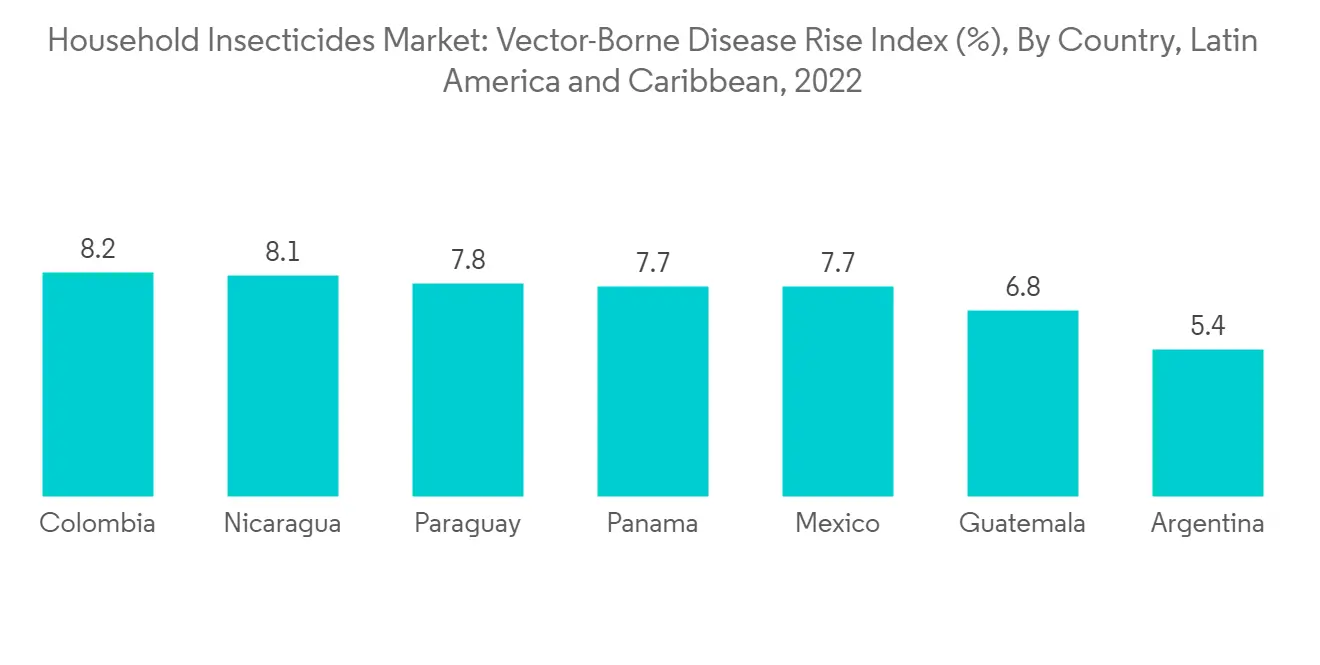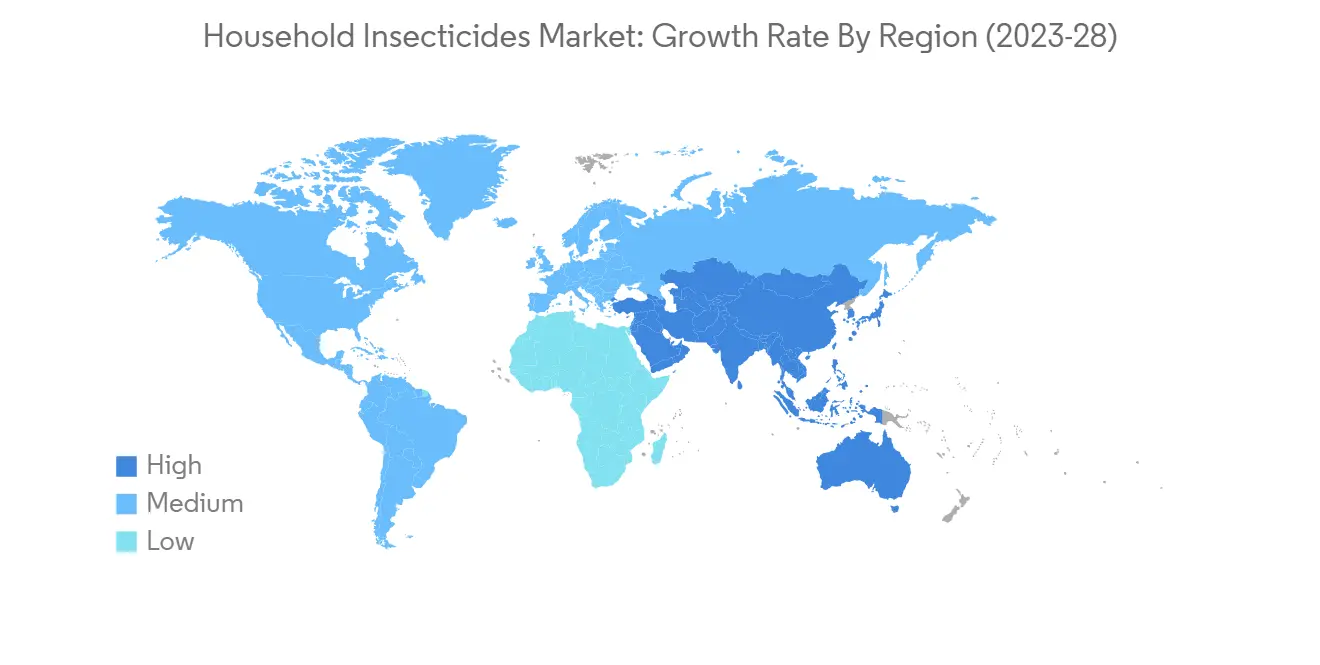
|
市場調査レポート
商品コード
1332508
家庭用殺虫剤の市場規模・シェア分析- 成長動向と予測(2023年~2028年)Household Insecticides Market Size & Share Analysis - Growth Trends & Forecasts (2023 - 2028) |
||||||
カスタマイズ可能
適宜更新あり
|
|||||||
| 家庭用殺虫剤の市場規模・シェア分析- 成長動向と予測(2023年~2028年) |
|
出版日: 2023年08月08日
発行: Mordor Intelligence
ページ情報: 英文 135 Pages
納期: 2~3営業日
|
- 全表示
- 概要
- 目次
家庭用殺虫剤の市場規模は2023年に172億4,000万米ドルと推定され、2028年には233億4,000万米ドルに達すると予測され、予測期間(2023-2028年)のCAGRは6.25%で成長すると予測されます。
主なハイライト
- マラリアなどの伝染性疾患による脅威の増大と、地方自治体や国家機関による媒介昆虫の防除重視の高まりが、予測期間中の市場を牽引すると予想されます。
- 家庭の消費者のニーズに応えるため、市場各社は使いやすく手間のかからない製品を通じて利便性を提供するようになっています。また、より安全で環境に優しい家庭用殺虫剤を求める傾向が強まっています。このため、従来の殺虫剤よりも安全性が高いとされる合成ピレスロイドの使用量が増加しています。
- 市場が直面する大きな課題のひとつは、昆虫の間で耐性昆虫が出現していることです。このため、より効果的で残効期間の長い、新しく革新的な殺虫剤が開発されています。もうひとつの課題は、殺虫剤が環境や人体に与える悪影響です。このため、より持続可能で環境に優しい解決策への需要が高まっています。そのため、より安全で持続可能な製品への注目が高まる中、媒介昆虫の駆除における効率と効果の向上を目指した新たな技術革新やソリューションの増加も相まって、予測期間中に業界の成長が見込まれています。
家庭用殺虫剤市場の動向
昆虫媒介性疾患の流行増加
- 昆虫、特に蚊やマダニは、マラリア、デング熱、ジカウイルス、ライム病、西ナイルウイルスなど、多くの病気の伝染の原因となっています。気候変動、都市化、世界の旅行の増加など、昆虫が媒介する疾病の流行が増加している理由はいくつかあります。
- 世界の都市人口が健康志向になり、人々は蚊に刺される危険性をより強く認識するようになっています。さらに、途上国では蚊が原因となる病気が増加するにつれ、農村部の人々の健康や衛生に対する関心も高まっています。
- 2020年3月に発表された世界保健機関(WHO)の報告書によると、媒介感染症は全感染症の17%以上を占めています。毎年、これらの病気によって70万人以上が死亡しています。加えて、エアコンや水を溜めるその他の電化製品の増加は、蚊の繁殖場所を提供する可能性があります。
- 気候変動は、昆虫が媒介する感染症が蔓延する主な原因のひとつです。世界の気温の上昇に伴い、多くの媒介昆虫の地理的範囲が拡大します。例えば、デングウイルスやジカウイルスの媒介蚊であるアジアタイガーモスは、気温の上昇により欧州や南北アメリカの新たな地域に広がっています。したがって、昆虫媒介性疾患の流行増加は、複合的な要因によって引き起こされる複雑な問題なのです。

アジア太平洋地域が市場を独占
- アジア太平洋地域では急速な都市化と人口増加が進んでおり、家庭用殺虫剤の需要が増加しています。より多くの人々が互いに近接して生活することで、虫の侵入や病気の蔓延の可能性が高まっています。さらに、この地域の人々の可処分所得が上昇しているため、殺虫剤を含む家庭用品への支出が増加しています。
- アジア太平洋地域では、デング熱のような媒介感染症も大きな懸念事項となっています。デング熱は蚊が媒介するウイルス性疾患で、この地域の多くの国で公衆衛生上の重大な問題となっています。デング熱やその他の媒介性疾患の発生率の上昇により、家庭内を無虫状態に保つことの重要性に対する認識が高まっています。これがこの地域における家庭用殺虫剤の需要を押し上げています。
- アジア太平洋地域の政府も、媒介感染症の問題に対処するための措置を講じています。家庭を虫のいない状態に保つことの重要性を啓蒙するキャンペーンを実施したり、殺虫剤を安全かつ効果的に使用するための規制を導入したりしています。全体として、アジア太平洋地域における家庭用殺虫剤市場の成長は、人口増加、都市化、可処分所得の増加、媒介感染症に対する懸念など、さまざまな要因が絡み合って牽引されています。同市場は予測期間中も成長を続けると予想されます。

家庭用殺虫剤産業の概要
家庭用殺虫剤市場は統合されており、大手企業が市場の大半のシェアを占めています。FMC Global Specialty Solutions、Godrej Consumer Products Limited、S.C Johnson & Son、Johnson and Johnson、Spectrum Brands、Natural INSECTO Products Inc.などが業界の大手企業です。製品革新は、農村部での市場浸透と都市部での消費拡大を図るために企業が採用する市場開発戦略です。プレーヤーはまた、売上を伸ばすために、テレビ、新聞、インターネット、ラジオ広告などの統合マーケティングコミュニケーションの開発にも力を入れています。
その他の特典:
- エクセル形式の市場予測(ME)シート
- 3ヶ月間のアナリストサポート
目次
第1章 イントロダクション
- 調査の前提と市場定義
- 調査範囲
第2章 調査手法
第3章 エグゼクティブサマリー
第4章 市場力学
- 市場概要
- 市場促進要因
- 市場抑制要因
- 業界の魅力- ポーターのファイブフォース分析
- 供給企業の交渉力
- 買い手の交渉力
- 新規参入業者の脅威
- 代替品の脅威
- 競争企業間の敵対関係の強さ
第5章 市場セグメンテーション
- 昆虫の種類
- 蚊・ハエ
- ネズミ・その他げっ歯類
- シロアリ
- ナンキンムシ・カブトムシ
- その他の昆虫タイプ
- 薬剤タイプ
- 合成
- N,N-ジエチル-メタ-トルアミド
- ピエリジンカルボン酸ヒドロキシエチルイソブチル
- その他の化学タイプ
- 天然
- シトロネラオイル
- ゲラニオールオイル
- その他の天然オイル
- 合成
- 形態
- ダスト・顆粒
- 液体
- エアゾールスプレー
- その他の形態
- 地域
- 北米
- 米国
- カナダ
- メキシコ
- その他北米
- 欧州
- ドイツ
- スペイン
- 英国
- フランス
- イタリア
- ロシア
- その他欧州
- アジア太平洋
- インド
- 中国
- シンガポール
- 日本
- オーストラリア
- その他アジア太平洋地域
- 南米
- ブラジル
- アルゼンチン
- その他南米
- アフリカ
- 南アフリカ
- その他の南アフリカ
- 北米
第6章 競合情勢
- 最も採用されている戦略
- 市場シェア分析
- 企業プロファイル
- Amplecta AB
- FMC Global Specialty Solutions
- Godrej Consumer Products Ltd
- Natural INSECTO Products, Inc.
- Nicols International Sa.
- S.C. Johnson & Son
- Shogun Organics
- Spectrum Brands Holding
第7章 市場機会と今後の動向
The Household Insecticides Market size is estimated at USD 17.24 billion in 2023, and is expected to reach USD 23.34 billion by 2028, growing at a CAGR of 6.25% during the forecast period (2023-2028).
Key Highlights
- Increased threats due to communicable diseases such as malaria and an increased emphasis on the control of insect vectors by local and national government bodies are expected to drive the market in the forecast period.
- To cater to the needs of household consumers, companies in the market are increasingly providing convenience through products that are easy to use and require minimal effort. In addition, there is a growing trend towards safer and more environment-friendly household insecticides. This has led to an increase in the usage of synthetic pyrethroids, which are considered to be safer than traditional insecticides.
- One of the major challenges facing the market is the emergence of insect resistance among insects. This has led to the development of new and innovative insecticides that are more effective and have a longer residual effect. Another challenge is the negative impact of insecticides on the environment and human health. This has led to increasing demand for more sustainable and eco-friendly solutions. Therefore, with an increasing focus on safer and more sustainable products, the industry is expected to grow during the forecast period, coupled with increasing new innovations and solutions aimed at improving efficiency and effectiveness in controlling insect vectors.
Household Insecticides Market Trends
Rising Prevalence of Insect-borne Diseases
- Insects, particularly mosquitoes and ticks, are responsible for the transmission of many diseases, such as malaria, dengue fever, Zika virus, Lyme disease, and West Nile virus, among others. There are several reasons for the rising prevalence of insect-borne diseases, including climate change, urbanization, and increased global travel.
- The global urban population is becoming more health-conscious, and people are becoming more aware of the risks of mosquito bites. Furthermore, as the number of diseases caused by mosquitoes increases in developing countries, the rural population is becoming increasingly concerned about health and hygiene.
- According to World Health Organization (WHO) report released in March 2020, vector-borne diseases accounted for more than 17% of all infectious diseases. Each year, these diseases cause more than 700,000 deaths. Additionally, the increase in air conditioning units and other appliances that hold water can provide breeding sites for mosquitoes.
- Climate change is one of the primary reasons for the increased prevalence of insect-borne diseases. As global temperatures rise, the geographic range of many insect vectors expands. For instance, the Asian tiger mosquito, a vector for dengue and Zika viruses, has spread to new parts of Europe and the Americas due to warming temperatures. Therefore, the rising prevalence of insect-borne diseases is a complex issue caused by a combination of factors.

Asia Pacific Dominates the Market
- The Asia-Pacific region is experiencing rapid urbanization and an increasing population, which has resulted in a rise in demand for household insecticides. With more people living in close proximity to each other, the chances of insect infestations and the spread of diseases increase. Additionally, the rising disposable incomes of people in this region have led to increased spending on household products, including insecticides.
- Vector-borne diseases like dengue fever are also a major concern in the Asia-Pacific region. Dengue fever is a mosquito-borne viral disease that has become a significant public health concern in many countries in this region. The rising incidence of dengue fever and other vector-borne diseases has led to increased awareness about the importance of keeping households insect-free. This has driven the demand for household insecticides in the region.
- Governments in the Asia-Pacific region have also taken steps to address the problem of vector-borne diseases. They have implemented awareness campaigns to educate people about the importance of keeping their homes insect-free and have also introduced regulations to ensure insecticides are used safely and effectively. Overall, the growth of the household insecticides market in the Asia-Pacific region is driven by a combination of factors, including population growth, urbanization, rising disposable incomes, and concerns over vector-borne diseases. The market is expected to continue to grow in the forecast period.

Household Insecticides Industry Overview
The household insecticides market is consolidated, with major players accounting for the majority of the share of the market. FMC Global Specialty Solutions, Godrej Consumer Products Limited, S.C Johnson & Son, Johnson and Johnson, Spectrum Brands, Natural INSECTO Products Inc., and others are some of the major players in the industry. Product innovation is a go-to-market strategy adopted by firms to increase market penetration in rural areas and consumption growth in urban areas. The players are also heavily focusing on developing integrated marketing communications like television, newspapers, Internet, and radio advertisements to increase sales.
Additional Benefits:
- The market estimate (ME) sheet in Excel format
- 3 months of analyst support
TABLE OF CONTENTS
1 INTRODUCTION
- 1.1 Study Assumptions and Market Definition
- 1.2 Scope of the Study
2 RESEARCH METHODOLOGY
3 EXECUTIVE SUMMARY
4 MARKET DYNAMICS
- 4.1 Market Overview
- 4.2 Market Drivers
- 4.3 Market Restraints
- 4.4 Industry Attractiveness - Porter's Five Forces Analysis
- 4.4.1 Bargaining Power of Suppliers
- 4.4.2 Bargaining Power of Buyers
- 4.4.3 Threat of New Entrants
- 4.4.4 Threat of Substitute Products
- 4.4.5 Intensity of Competitive Rivalry
5 MARKET SEGMENTATION
- 5.1 Insect Type
- 5.1.1 Mosquitoes & Flies
- 5.1.2 Rats & other Rodents
- 5.1.3 Termites
- 5.1.4 Bedbugs & Beetles
- 5.1.5 Other Insect Types
- 5.2 Chemical Type
- 5.2.1 Synthetic
- 5.2.1.1 N, N-Diethyl-Meta-Toluamide
- 5.2.1.2 Hydroxyethyl Isobutyl Pieridine Carboxylate
- 5.2.1.3 Other Chemical Types
- 5.2.2 Natural
- 5.2.2.1 Citronella Oil
- 5.2.2.2 Geraniol Oil
- 5.2.2.3 Other Natural Oils
- 5.2.1 Synthetic
- 5.3 Form
- 5.3.1 Dust and Granules
- 5.3.2 Liquids
- 5.3.3 Aerosol Sprays
- 5.3.4 Other Forms
- 5.4 Geography
- 5.4.1 North America
- 5.4.1.1 United States
- 5.4.1.2 Canada
- 5.4.1.3 Mexico
- 5.4.1.4 Rest of North America
- 5.4.2 Europe
- 5.4.2.1 Germany
- 5.4.2.2 Spain
- 5.4.2.3 United Kingdom
- 5.4.2.4 France
- 5.4.2.5 Italy
- 5.4.2.6 Russia
- 5.4.2.7 Rest of Europe
- 5.4.3 Asia-Pacific
- 5.4.3.1 India
- 5.4.3.2 China
- 5.4.3.3 Singapore
- 5.4.3.4 Japan
- 5.4.3.5 Australia
- 5.4.3.6 Rest of the Asia-Pacific
- 5.4.4 South America
- 5.4.4.1 Brazil
- 5.4.4.2 Argentina
- 5.4.4.3 Rest of South America
- 5.4.5 Africa
- 5.4.5.1 South Africa
- 5.4.5.2 Rest of Souh Africa
- 5.4.1 North America
6 COMPETITIVE LANDSCAPE
- 6.1 Most Adopted Strategies
- 6.2 Market Share Analysis
- 6.3 Company Profiles
- 6.3.1 Amplecta AB
- 6.3.2 FMC Global Specialty Solutions
- 6.3.3 Godrej Consumer Products Ltd
- 6.3.4 Natural INSECTO Products, Inc.
- 6.3.5 Nicols International Sa.
- 6.3.6 S.C. Johnson & Son
- 6.3.7 Shogun Organics
- 6.3.8 Spectrum Brands Holding


